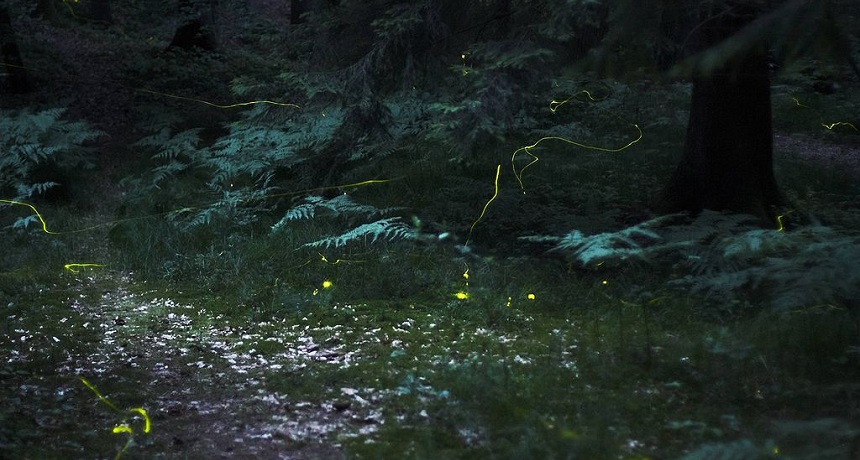Free app tracks fireflies
Counting lightning bugs can help scientists track this important insect

There are over 2,000 species of fireflies, including these shown in a long-exposure photo taken in a forest near Nuremberg, Germany. A free app lets you map firefly flashes and contribute data to tracking the health of this popular summertime bug.
Quit007/Wikimedia Commons
That first flashing firefly at dusk means summer is here. Now, you can put part of your summer vacation to good use, with a firefly-tracking smartphone app. Its data could contribute to important research on these glowing little bugs.
Fireflies inspire songs, books, and even the names of TV shows. There are over 2,000 species of these dusk-loving lightning bugs all over the world. But some scientists are worried that people may be destroying the the insects’ habitat or killing them with pesticides. Other pollutants could be poisoning the water and soil they depend on.
To learn more about firefly populations, scientists at Clemson University in Clemson, S.C., have built a free program for smartphones. They want people to use this firefly app to let them know where the lightning bugs flit from night to night. The data that these citizen scientists collect can help map where various species of fireflies live.
The researchers are seeking data on fireflies worldwide, to see whether their populations are increasing or decreasing. Fireflies are a bioindicator, a species ecologists monitor to help gauge how healthy an ecosystem is. If fireflies disappear, it might be a sign their habitat is in trouble. “We are studying long term effects,” notes Alex Chow. He’s a soil and water chemist who helped develop the new app. “We can’t get an answer from one or two years of data,” he explains. The scientists need many years of data from many places if they want to chart the fireflies’ abundance over time.
To collect data from many locations at once, the scientists can’t work alone. They need citizen scientists, people of all ages who can assist them. “Everyone loves fireflies, and they are easy to spot,” Chow explains. “This makes the firefly project perfect for citizen science.”
The app is simple and videos are available on the website offering directions for kids and adults. Just download the free app to your smartphone. When you go outside at night, find a comfortable spot to sit. Then make a circle with your thumb and index finger, and hold it up to your eye. Now count all the firefly flashes you can see through that circle over the next minute. Tap the smartphone each time you see one.
The program then will ask for your location and what type of environment you are in. Are you on a farm, in your backyard or sitting in a parking lot? The app will also ask what kind of flashes you saw. Not all fireflies flash at the same rate, or glow the same color. “Different species have different flashing patterns,” Chow explains. Those flashes are the way the bugs try to attract a would-be mate. So by flashing a different signal, these bugs “make sure they don’t get the wrong species of boyfriend or girlfriend.”
Descriptions of some of the most common flash patterns in North America are available on the website. These include the J-shape, single flashes or bursts of two or three flashes at once. There is also plenty of background information about fireflies, so citizen scientists can learn more about the bugs they are observing.
Last year, citizen scientists monitored fireflies for just two hours on a single day. But this year, Chow hopes that people will use the app throughout the peak season — from May 31 to Aug. 31. So download the app. Then, the next time you are out at night and see a firefly, help scientists get the data they need to keep the friendly bugs flashing.
Follow Eureka! Lab on Twitter
Power Words
app Short for application, or a computer program designed for a specific task.
bioindicator A species used to measure the health of an ecosystem. Bioindicator species could be plants, animals, fungi or any other organism sensitive to pollution or other changes in their environment. The health or presence of the species can offer one sign of the health of the ecosystem in which it lives.
chemistry The field of science that deals with the composition, structure and properties of substances and how they interact with one another. Chemists use this knowledge to study unfamiliar substances, to reproduce large quantities of useful substances or to design and create new and useful substances.
citizen science Scientific research in which the public — people of all ages and abilities — participate. The data that these citizen “scientists” collect helps to advance scientific research. Citizen science means that scientists can get data from many more people and places than would be available if they were working alone.
ecosystem A group of interacting living organisms — including microorganisms, plants and animals — and their physical environment within a particular climate. Examples include tropical reefs, rainforests, alpine meadows and polar tundra.
firefly An insect in the family Lampyridae.Also called lightning bugs, fireflies are not flies at all, but beetles. They are known for their beautiful nighttime flashes of light, called bioluminescence. There are over 2,000 species of firefly around the world.
habitat The area or natural environment in which an animal or plant normally lives, such as a desert, coral reef or freshwater lake. A habitat can be home to thousands of different species.
pesticide A chemical or mix of compounds used to kill insects, rodents or other organisms harmful to cultivated plants, pet or livestock, or unwanted organisms that infest homes, offices, farm buildings and other protected structures.
smartphone A cell (or mobile) phone that can perform a host of functions, including search for information on the Internet.







